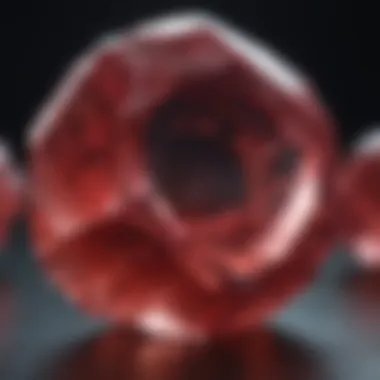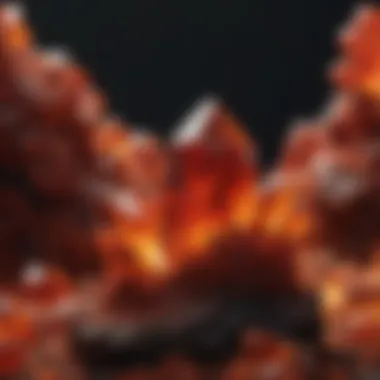Unveiling the Enigmatic Universe of Red Minerals: A Journey of Discovery


Rock and Fossil Identification
Red minerals encompass a diverse array of geological wonders that exhibit captivating shades of red, from the brilliant crimson of cinnabar to the deep maroon of vanadinite. Identifying these unique specimens requires a keen eye for detail and a thorough understanding of their key characteristics. When examining red minerals, it is essential to look for distinct color patterns, crystal structures, and mineral compositions that set them apart from other minerals. Specialized tools such as loupes, streak plates, and hardness testing kits can aid in the precise identification of red minerals, making the process both engaging and rewarding for enthusiasts.
Geological Insights
The geological origins of red minerals offer a fascinating glimpse into the Earth's ancient history and intricate processes. These vibrant specimens are often associated with specific geological formations and mineral deposits, providing valuable insights into the dynamic forces that have shaped our planet over millions of years. By studying the occurrence of red minerals within different rock layers and stratigraphic sequences, scientists can unravel clues about past environments, tectonic events, and mineralization processes. Notable discoveries in the field of red mineralogy have contributed to our understanding of Earth's complex geology and enriched our appreciation for the natural wonders that lie beneath the surface.
Introduction to Red Minerals
Understanding the Significance of Red Minerals
Origins of the Red Coloration
Exploring the Origins of the Red Coloration in minerals is crucial to understanding their unique appeal. The red hues in minerals are often a result of specific trace elements present during their formation process. For example, minerals containing iron oxide typically exhibit vibrant red colors. This distinctive coloration not only adds aesthetic value but also offers insights into the mineral's composition and geological history. Understanding the Origins of the Red Coloration provides a glimpse into the intricate processes that result in these visually striking minerals, enhancing our appreciation for their natural beauty.
Impact of Trace Elements
The Impact of Trace Elements on red minerals plays a significant role in determining their physical properties and appearance. Trace elements such as chromium, manganese, and copper can influence the color intensity and transparency of red minerals. These elements interact with the mineral's crystal structure, resulting in unique color variations and patterns. By examining the Impact of Trace Elements, we can decipher the complex chemistry behind the mesmerizing red hues seen in minerals like cinnabar and rhodochrosite, deepening our understanding of their geological significance.
Geological Context
Contextualizing red minerals within their geological framework unveils the environmental conditions that shaped their formation. Red minerals occur in diverse geological settings, including volcanic environments, sedimentary layers, and hydrothermal veins. Each geological context offers distinct clues about the mineral's history, highlighting processes such as magma crystallization or metamorphic transformation. By exploring the Geological Context of red minerals, we gain a holistic view of their origins and distribution, connecting their vibrant appearance to the dynamic forces at work beneath the Earth's surface.
Popular Red Minerals
Within the realm of red minerals lie several popular varieties that have captured the attention of collectors and enthusiasts worldwide. Let's delve into the unique characteristics and significance of some of the most sought-after red minerals:
Cinnabar
Cinnabar, with its deep red color and striking luster, has been treasured for centuries for its beauty and rarity. This mercury sulfide mineral not only boasts a vibrant hue but also holds cultural and historical importance due to its use in traditional medicine and artistic endeavors. The unique feature of Cinnabar lies in its association with mercury, making it a valuable but also potentially hazardous mineral for collectors to handle.
Vanadinite
Vanadinite showcases stunning red-orange crystals that captivate the eye with their intense coloration. This lead chlorovanadate mineral stands out for its distinct hexagonal prismatic crystal structure and exceptional transparency. Collectors admire Vanadinite not only for its aesthetic appeal but also for its significance in the study of mineralogy. Its widespread availability across various geological formations makes Vanadinite a favored choice for both amateur collectors and seasoned geologists.
Rhodochrosite


Rhodochrosite's rose-red to pink hues make it a beloved gemstone in the world of red minerals. This manganese carbonate mineral exhibits banded patterns and intricate crystal formations, adding to its allure as a collector's item. The unique feature of Rhodochrosite lies in its associations with emotional healing and compassion, making it a sought-after crystal in metaphysical practices. Its delicate appearance and metaphysical qualities make Rhodochrosite a versatile and prized addition to any mineral collection.
Realgar
Realgar, known for its fiery red color and distinctive arsenic composition, is both a striking and toxic mineral. This arsenic sulfide mineral has been used historically as a pigment, showcasing its vivid red tones in traditional artwork. While Realgar's vibrant appearance adds an artistic flair to mineral collections, collectors must handle it with caution due to its arsenic content. The unique feature of Realgar lies in its dual nature as a visually appealing yet potentially harmful mineral, challenging collectors to admire its beauty from a safe distance.
Rhodonite
Rhodonite's rich pink to red hues, often interspersed with black manganese oxide veins, make it a visually distinctive mineral. This manganese inosilicate mineral is sought after for its unique color patterns and associations with emotional balance and love. The key characteristic of Rhodonite is its contrasting colors and intricate veining, creating a visual spectacle in mineral specimens. Collectors value Rhodonite not only for its aesthetic appeal but also for its supposed metaphysical properties, adding depth and meaning to their mineral collections.
Hematite
Hematite's metallic luster and deep red color make it a popular choice among mineral enthusiasts and jewelry makers. This iron oxide mineral is renowned for its reflective properties and healing associations, believed to ground and stabilize energies. The key characteristic of Hematite lies in its magnetism and high iron content, making it a versatile mineral for both aesthetic and practical applications. Whether used in jewelry crafting or displayed as a specimen, Hematite's unique appearance and metaphysical attributes appeal to a wide audience.
Historical Significance
Red minerals hold a profound historical significance that transcends their visual appeal, weaving a narrative of ancient uses, symbolic importance, and artistic expression. Let's uncover the historical relevance of red minerals through their diverse applications and cultural interpretations:
Ancient Uses and Beliefs
The Ancient Uses and Beliefs surrounding red minerals span centuries and civilizations, reflecting their multifaceted roles in medicine, ritual practices, and ornamentation. Red minerals like cinnabar and hematite were prized for their healing properties and protective qualities, used in amulets and ceremonial objects. The key characteristic of Ancient Uses and Beliefs is their enduring influence on human culture, shaping beliefs about the intrinsic powers of red-hued stones. By tracing the historical journey of red minerals through ancient civilizations, we gain a deeper understanding of their symbolic resonance and practical applications.
Symbolism in Different Cultures
Red minerals have held symbolic significance in diverse cultures worldwide, representing themes of love, vitality, and spiritual energy. From the symbolic associations of red coral in Mediterranean traditions to the reverence for red jasper in Native American rituals, each culture imparts unique meanings to red-hued stones. The key characteristic of Symbolism in Different Cultures is its ability to bridge cultural divides and convey universal themes through the language of minerals. By exploring the symbolic richness of red minerals across different traditions, we unravel a tapestry of beliefs and values intertwined with these captivating geological treasures.
Red Minerals in Art
Red minerals have been a source of inspiration for artists throughout history, serving as pigments, gemstones, and decorative elements in artistic creations. The vivid hues of red minerals like vermillion and cinnabar have graced paintings, sculptures, and jewelry, adding depth and vibrancy to artistic expressions. The unique feature of Red Minerals in Art lies in their dual role as aesthetic enhancers and cultural symbols, blending beauty with meaning in the realm of artistic production. By examining the artistic legacy of red minerals, we illuminate their enduring impact on creative practices and aesthetic sensibilities.
Formation and Characteristics
The Formation and Characteristics of red minerals offer a glimpse into the intricate processes that govern their growth, structure, and physical properties. By unraveling the crystallography, chemical compositions, and growth patterns of red minerals, we can appreciate the natural phenomena that result in their captivating allure:
Crystal Structure
Examining the Crystal Structure of red minerals unveils the precise arrangement of atoms and molecules that define their crystalline form. Red minerals exhibit diverse crystal systems, from cubic structures in cinnabar to trigonal configurations in rhodochrosite, influencing their optical and physical properties. The key characteristic of Crystal Structure lies in its role in determining the mineral's symmetry, cleavage patterns, and color display. By dissecting the crystallography of red minerals, we gain insights into their fundamental building blocks and aesthetic diversity.


Physical Properties
The Physical Properties of red minerals encompass a range of traits, including hardness, cleavage, and specific gravity, that distinguish them from other geological specimens. These properties play a crucial role in mineral identification, classification, and practical applications. Red minerals like hematite exhibit distinct metallic luster and streak characteristics, aiding in their recognition and differentiation from similar-looking minerals. The unique feature of Physical Properties is their direct link to the mineral's composition and structure, offering valuable clues about its geological history and formation processes.
Crystal Growth
Understanding the processes of Crystal Growth sheds light on how red minerals form and evolve over time in response to environmental conditions. Factors such as temperature, pressure, and mineral-rich fluids influence the nucleation and growth of crystals, shaping their size, shape, and internal features. The key characteristic of Crystal Growth is its sensitivity to external stimuli, resulting in varied crystal habits and morphologies. By examining the intricate pathways of crystal growth in red minerals, we uncover the dynamic interplay between natural forces and mineralogical transformations, enriching our appreciation for these geological marvels.
Notable Locations for Red Minerals
In the realm of red minerals, notable locations play a crucial role in showcasing the diverse and mesmerizing formations that captivate rock and fossil collectors. These locations serve as geological hotspots, housing an array of red minerals that intrigue geology enthusiasts worldwide. By exploring these notable locations, collectors can witness firsthand the unique characteristics and vivid hues that make red minerals so fascinating.
Worldwide Deposits
Spain
Spain stands out as a prominent location for red minerals, boasting a rich geological history that has yielded an abundance of stunning specimens. The country's diverse landscapes, characterized by volcanic activity and mineral-rich deposits, provide an ideal environment for the formation of various red minerals. The renowned Almadén Mine in Spain is particularly famous for producing cinnabar, a vibrant red mineral prized for its striking coloration and historical significance. Collectors flock to Spain for its exceptional specimens and the opportunity to witness the beauty of red minerals in their natural habitat.
China
China emerges as another significant hub for red minerals, showcasing a wide range of distinct specimens that reflect the country's geological diversity. From the intricate formations found in the Sichuan Province to the vibrant red vanadinite crystals discovered in various regions, China offers collectors a treasure trove of unique specimens. The country's geological richness and mineral deposits make it a favored destination for collectors seeking rare and remarkable red minerals.
USA
The United States boasts diverse geological formations that host a multitude of red minerals, making it a premier destination for collectors worldwide. Iconic mines like the Red Cloud Mine in Arizona and the Sweet Home Mine in Colorado have produced exceptional specimens, drawing collectors with their quality and aesthetic appeal. With a wide variety of red minerals available across different states, the USA stands out as a top location for enthusiasts looking to expand their collections.
Peru
Peru's geological landscape offers a unique setting for red mineral formations, with notable deposits found within its varied terrain. The Uchucchacua Mine in Peru is renowned for its production of distinctive red minerals, showcasing the country's geological diversity and mineralogical significance. Collectors are intrigued by Peru's rich mineral sources, which highlight the country's contribution to the world of red minerals.
Australia
Australia's geological heritage includes a range of red mineral deposits that appeal to collectors interested in unique and rare specimens. With notable locations like the Agnew Mine in Western Australia and the Broken Hill Mine in New South Wales, Australia presents a compelling destination for enthusiasts seeking diverse red minerals. The country's geological formations and mineral wealth make it an important location in the exploration of red minerals.
Collecting and Preserving Red Minerals
In the realm of red minerals, the topic of collecting and preserving holds paramount importance. As avid enthusiasts and collectors delve into the world of red minerals, understanding the significance of proper collection and preservation techniques becomes essential. Not only does it ensure the longevity of these precious specimens, but it also contributes to the overall knowledge base of geological formations and mineral compositions.


Best Practices for Collectors
Field Identification
Field identification plays a crucial role in the process of collecting red minerals. It allows collectors to differentiate between various mineral specimens, aiding in accurate cataloging and classification. The keen ability to identify red minerals directly in their natural environment provides collectors with a firsthand understanding of geological contexts and formations. While field identification enhances the authenticity of collections, it also fosters a deeper connection between enthusiasts and the earth's mineral treasures.
Cleaning and Storage
Maintaining red minerals in pristine condition requires meticulous cleaning and storage practices. Proper cleaning techniques help preserve the vibrant hues and distinctive features of each specimen, ensuring their lasting beauty. Additionally, strategic storage solutions protect red minerals from environmental factors that could compromise their integrity. By implementing optimal cleaning and storage methods, collectors can safeguard their prized possessions for generations to come.
Ethical Collection Practices
Ethical collection practices entail a profound respect for the natural environment and adherence to legal regulations. Collectors committed to ethical practices prioritize sustainability, ensuring that their hobby does not harm ecosystems or deplete mineral resources. By engaging in ethical collection methods, enthusiasts contribute to the preservation of geological wonders and promote responsible stewardship of the earth's red mineral treasures.
Preservation Techniques
Preserving red minerals involves employing specialized techniques to maintain their intrinsic qualities and structural integrity. From preventing oxidation to shielding specimens from UV light, preservation methods are essential in conserving the visual appeal and scientific value of red minerals.
Preventing Oxidation
Preventing oxidation is a critical aspect of mineral preservation, especially for red minerals susceptible to color changes due to exposure to air. Through proactive measures such as controlled environments and protective coatings, collectors can effectively combat oxidation and retain the authentic coloring of their specimens. By prioritizing oxidation prevention, enthusiasts uphold the true essence of red minerals in their collections.
Protecting from UV Light
Shielding red minerals from UV light is paramount to prevent color fading and structural deterioration. UV radiation can accelerate the degradation of mineral surfaces over time, diminishing their aesthetic appeal and scientific significance. Implementing UV protection strategies, such as display cases or UV-filtering coatings, ensures that red minerals retain their allure and integrity for years to come.
Display and Exhibition
Displaying red minerals not only showcases their beauty but also educates and inspires viewers about the wonders of geology. Thoughtful exhibition of mineral specimens enhances their visual impact and allows for closer examination of intricate details. Whether in personal collections or public exhibitions, proper display techniques contribute to the appreciation and preservation of red minerals' remarkable features.
Legal Considerations
Navigating the legal landscape surrounding red mineral collection is imperative for collectors to uphold ethical standards and comply with regulatory frameworks. Understanding regulations on collection, international trade restrictions, and ethical sourcing practices empowers enthusiasts to engage responsibly in their hobby while respecting legal boundaries.
Regulations on Collection
Regulations on collection dictate permissible practices for acquiring red minerals, safeguarding natural resources and heritage sites. By adhering to established guidelines, collectors support conservation efforts and mitigate the negative impact of indiscriminate mineral extraction. Compliance with collection regulations demonstrates a commitment to ethical stewardship of red mineral specimens.
International Trade Restrictions
International trade restrictions govern the cross-border movement of red minerals, aiming to protect endangered species, cultural artifacts, and geological sites of significance. Compliance with trade regulations preserves global mineral diversity and prevents illicit trafficking of rare specimens. Awareness of international trade restrictions is essential for responsible participation in the mineral collecting community.
Ethical Sourcing
Ethical sourcing practices uphold principles of sustainability, fair trade, and respect for indigenous rights in the acquisition of red minerals. By sourcing specimens from reputable suppliers and transparent supply chains, collectors ensure that their hobby promotes positive environmental and social impacts. Prioritizing ethical sourcing ultimately contributes to the preservation of red minerals and supports sustainable practices within the industry.







